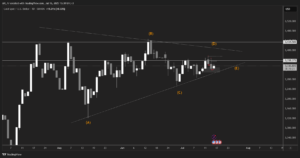After gold prices (XAU/USD) had risen earlier in the year, analysts at ABN AMRO bank remained cautious about their gold price outlook and maintained their forecast at $2,000 an ounce by December 2024.Experts at the Dutch bank noted that gold prices this year have been supported by investor buying of the yellow metal in futures markets and in other forms, and by central banks building their gold reserves.
ABN AMRO economists said that gold prices lost momentum from their high of $2,450 seen on May 20, 2024, and that gold prices have a key support zone between $2,220-2,275, where layers of tops and bottoms are placed, and that the next support zone is at $2,115, and if prices fall below this level, the long-term trend will turn negative.Bank experts noted that it is unusual for gold prices to have positive correlations with the US dollar and 5-year and 10-year US Treasury yields; but the experts maintained their year-end gold forecast at $2,000 an ounce.
Important statements from the Fed: Hawkish tone and talk of a cut on this date
Raphael Bostic, president and CEO of the Atlanta Federal Reserve Bank, said there is a possibility of a federal funds rate cut in the fourth quarter of this year, emphasizing that future decisions will be data-dependent.
Bostic noted that there are plans to cut rates five times in 2025, but he stressed that these projections are not final given the current economic uncertainty, meaning that a rate cut, hold, or even hike could all be options depending on how things develop.”There are potential scenarios that might require more rate cuts, or no rate cuts at all, or even rate hikes,” Bostic said in a prepared speech. “I will rely on the data and the conditions on the ground to make my decisions.”
He also reaffirmed his commitment to lowering the inflation rate to the 2% target, noting that achieving this goal is essential for achieving broad prosperity and making effective decisions among households and businesses.He explained that achieving this goal does not mean lowering prices to pre-2021 levels, but rather aims to create an economic environment in which inflation does not significantly affect consumer and producer thinking.Bostic noted the need to look beyond the headline numbers, explaining that despite some signs of life returning to normal, the economy is still heavily impacted by the COVID-19 pandemic.
He added that the effects of the policy actions taken in response to the pandemic have supported the labor market and the economy in general, even in the face of significant monetary tightening.The housing sector is one of the first economic sectors to feel the effects of monetary policy changes due to its sensitivity to interest rates.Real estate bank executives said their industry has been in an actual recession for the past year as mortgage rates have risen above 7%, a significant increase from previous rates.
Why did oil prices rise?
Oil prices rose in Asian trading today, Friday, and are on track for strong gains in June, as supply disruption concerns in Russia and the Middle East largely offset demand slowdown worries.This period also saw oil prices rise after data this week showed an unexpected increase in US inventories. Gasoline inventories also rose despite the start of the busy summer travel season.Crude oil futures rose during the Asian session on Friday.
According to the New York Mercantile Exchange, August crude oil futures were trading at USD82.26 per barrel as of this writing, up 0.64%.August crude futures were previously traded at USD82.28 per barrel. Crude oil may find support at USD80.18 and resistance at USD82.28.Dollar Index futures, which measure the performance of the US dollar against a basket of six other major currencies, rose 0.13% to trade at USD105.71.Meanwhile, on Nymex, September Brent oil rose 0.54% to trade at USD85.72 per barrel, while the spread between Brent and crude oil futures stands at USD3.46 per barrel.
Disclaimer: This article is not investment advice or an investment recommendation and should not be considered as such. The information above is not an invitation to trade and it does not guarantee or predict future performance. The investor is solely responsible for the risk of their decisions. The analysis and commentary presented do not include any consideration of your personal investment objectives, financial circumstances, or needs.





